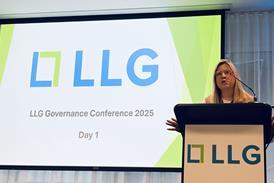It’s remarkable how quickly myths and conspiracy theories can spread, especially when it comes to reform.

Over the past week, I’ve seen the rumour mill working overtime on what the government’s consultations into home buying and selling reform, and material information, might mean for the conveyancing sector.
Both consultation papers explicitly recognise the central role of the conveyancer. Far from removing the profession, the proposed reforms aim to strengthen it, by ensuring conveyancers are engaged earlier, spend less time chasing missing information, and can focus on advising clients. This is about empowerment, not erasure.
The aim is simple: make buying and selling a home safer and less stressful by making property data digital, verified and shareable. That’s not the end of conveyancing; it’s the end of avoidable delays, duplication and scope creep.
Some rumour-mongers have drawn parallels with the US system, where title insurance replaces due diligence. But that model was born out of the American Civil War where deeds were destroyed, and Native American land claims and lost deeds meant no one could be sure who owned what. Insurers stepped in because there was no reliable land register and there still is no federal land registry.
In the UK, we already have one of the most secure and transparent systems of land registration in the world. HM Land Registry provides a state guarantee of title. We insure known risks (like a breach of covenant or missing consent) rather than unknown ones. That’s a crucial distinction.
And the cost comparison tells its own story: in the US, title insurance can cost many thousands per transaction. In the UK, the government’s own consultation notes that digitalisation could reduce waste by £340 on average - that’s the waste incurred by stakeholders and consumers in the 20 weeks of chasing for updates and documents, and lost revenue from fall throughs.
So, the reforms are not looking at replacing conveyancers and valuers with costly insurance policies, they’re looking at streamlining our work so we can deliver timely advice to clients on the information material to them. For a seller, that is the material information which would impact the average buyer; for a buyer it is the information material to their intended use and enjoyment; and for a lender, it is the information material to their lending risk policy.
Read more
Understanding that nuance is key. Material information does not get rid of the need for conveyancers to advise buyers or mean we are expected to advise on anything which we do not have expertise, or insurance, to advise on.
Indeed, by digitalising property data, the buyer and lender can be pointed to the correct professional adviser, for example, the physical aspect will be advised by the surveyor and the legal transaction and title by the conveyancer. Complexities like escalating ground rents can be advised on by a financial adviser as to affordability, conveyancer as to the legal aspects and a mortgage broker as to the lenders who will lend.
Digitalisation also doesn’t mean automation of advice. It means reducing the administrative burden and freeing professionals to focus on where their expertise really matters: interpreting the law, protecting the client, and resolving complex issues.
The reforms aim to:
- Create verified, digital property logbooks that hold key data on every home like title, energy performance, restrictions and building safety - available at the start of the transaction. Is it only me that is old enough to remember how easy it was when we had deeds packets holding the core information? Even old searches that did need to be refreshed but rarely changed?
- Use the Unique Property Reference Number (UPRN) to link all property data across systems.
- Standardise material information so buyers, sellers and lenders can rely on the same facts, the provenance of which has been verified so you know whether the source is safe.
- Enable secure data sharing via the Property Data Trust Framework, reducing duplication of ID checks and enquiries.
In other words, the government wants to digitise the process, not deskill the profession. Conveyancers will remain the legal experts who interpret and advise but they’ll have access to better data, sooner.
It’s worth remembering the last time we tried to improve upfront information. When Home Information Packs (HIPs) were introduced, critics predicted the end of the housing market. In fact, ONS data later showed no reduction in completions, just fewer fall-throughs. In Scotland, where Home Reports remain mandatory, transaction volumes stayed strong while consumer satisfaction rose.
HIPs failed not because the principle was wrong, but because implementation was patchy and digital tools were limited. Two decades later, the technology and regulatory frameworks now exist to make this work, and to make it work for conveyancers.
So, let’s not fall for the idea that digitalisation is a threat. The reality is these reforms are long overdue, and they’re designed to elevate the conveyancing profession, not eliminate it.
By embracing digital tools, verified data, and early involvement, conveyancers will finally be able to focus on what clients value most - trusted, expert advice and a smooth path to completion.
At the recent Digital Property Market Steering Group event, the Ministry deputy director Victoria Latham, who chairs the DPMSG, told us that we could tell anyone who asks about these conspiracy theories that they are nonsense and to read the consultation which makes it clear the solutions support the industry making it easier for us, the consumer and the economy.
It’s therefore time to put the conspiracy theories to bed and get on with shaping the modern, connected home-moving process which we and our clients deserve.
Beth Rudolf is director of delivery at the Conveyancing Association
This article is now closed for comment.
































14 Readers' comments